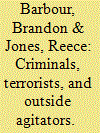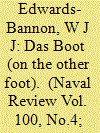|
|
|
Sort Order |
|
|
|
Items / Page
|
|
|
|
|
|
|
| Srl | Item |
| 1 |
ID:
121436


|
|
|
|
|
| Publication |
2013.
|
| Summary/Abstract |
This article is a critical geopolitical analysis of Chinese media representations of the 5 July 2009 riots in Xinjiang, China. Significant events often define the geopolitical climate by creating a space for the construction of boundaries between identity categories and the appropriate norms for behaviour towards the Other. The post-riot reports framed the event through the prism of the global war on terror to justify a violent response to protect Chinese citizens from the perceived threat of the Other. After connecting theories of narratives, the event, and group making, the article identifies three representational tropes - the criminal, the terrorist, and the outside agitator - in Chinese documents that create boundaries between the identity categories Uyghur and Han and define how the Other should be treated. The three representation tropes of the Other in the aftermath of the 5 July riots simultaneously situate the protestors as outside Chinese society and perpetuate the claim of the superiority of Chinese culture and civilisation.
|
|
|
|
|
|
|
|
|
|
|
|
|
|
|
|
| 2 |
ID:
127392


|
|
|
| 3 |
ID:
123371


|
|
|
|
|
| Publication |
2013.
|
| Summary/Abstract |
The end of the cold war witnessed the emergence of a commercial web sprawling from the Xinjiang Uighur Autonomous Region in western China and extending into Central Asia (Kazakhstan, Kyrgyzstan, Tajikistan, Turkmenistan, and Uzbekistan), Pakistan, and Russia. Running parallel to the state-managed exchange in hydrocarbons, raw materials, technology, and infrastructure, this new Eurasian trade had an informal component as everyday consumer items manufactured in China were imported into neighboring countries, bypassing formal regulatory mechanisms. This inter-Asian trade began as shuttle trading by itinerant merchants for local markets; by the mid 1990s, shuttle trading was overshadowed by large-scale export for national markets in neighboring countries without losing its informal character. This informality extending across national boundaries defined the post-cold war commerce in innermost Asia; at the same time, it also signaled a return to pre-cold war trading structures. Moving away from the "retreat of the state" thesis that found traction following the cold war, the author attributes informality in this inter-Asian trade to three factors: (1) a restructuring of state power where informal trade was a new comparative advantage sought in an evolving geopolitical climate; (2) the actors in this inter-Asian trade - party and regional officials in China, along with traders and intermediaries - who found and exercised agency through this exchange; and (3) a chain of inter-locking, commercial macro-regions, which are economically sustainable and which transcended international boundaries. Working in conjunction, these factors constitute a dynamic inter-Asian trade and challenge static state imaginaries of a "New Silk Road" or "Eurasian Continental Bridge."
|
|
|
|
|
|
|
|
|
|
|
|
|
|
|
|
|
|
|
|
|